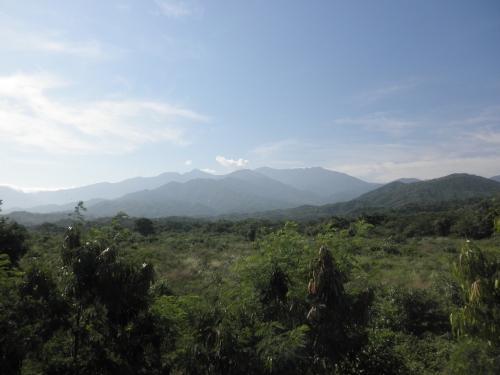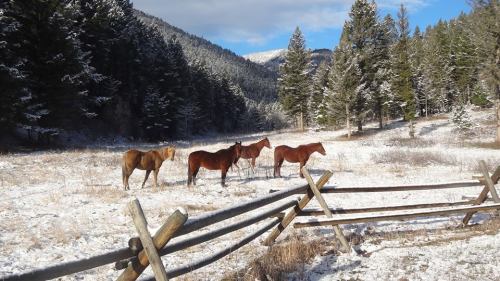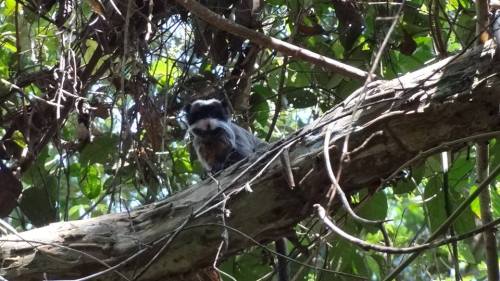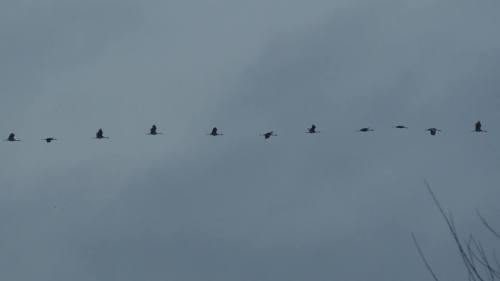What’s New?
Happy Earth Day!
Happy Earth Day! I’m excited to see that National Geographic is celebrating Earth Day 2016 with a magazine dedicated to Yellowstone National Park, one of the shared treasures between my home state of Montana and our neighbor to the south, Wyoming. Yellowstone is a remarkable place, where I’ve been blessed to spend many days exploring gurgling mudpots and steam-spewing geysers, heavy-breathing bison herds on crisp winter mornings, grizzly and wolf spottings, and innumerable glimpses of elk, coyote, bear, deer, foxes, goats, eagles, and of course, wide-eyed tourists. While I wait to bring my own children to know Yellowstone, this Earth Day edition of National Geographic will have to tide me over 🙂 It certainly doesn’t hurt that National Geographic brought together Montana-writer extraordinaire David Quammen with phenomenal photographer Michael Nichols (both celebrated as well for their excellent work in Gabon) to tease out the nuances and wonders of Yellowstone.
Yellowstone to Yukon (Y2Y) Features Wildways: Corridors of Life film on PBS’ Nova
Connectivity, one of the critical concepts of wildlife and landscape scale protection, is a key part of conservation efforts – to ensure that protected areas, and the species within, are also able to travel from protected areas to areas beyond. Y2Y, a conservation initiative seeking to expand connectivity from the Yellowstone to the Yukon, exemplifies this concept through its work on grizzly bears and many other species. Y2Y recently discussed a new film on PBS’ Nova program that further explores connectivity and wildlife corridors. Definitely worth your time to read about the initiative and watch the film!
Day 7 Facebook #challengeonnaturephotography
Day 7 of my #challengeonnaturephotography! This week has flown by. Perhaps the most important aspect of promoting wildlife conservation, and ensuring efforts are sustainable and successful, is to ensure that local communities with the largest stake in the actual lands and wildlife that surround them are the key actors in conservation efforts. As a Peace Corps volunteer in Gabon, I was blessed to be able to work in elementary and secondary schools, with incredibly motivated students, teachers, and families to explore sustainable methods to promote conservation of Gabon’s outstanding biodiversity. This photo is from a nightly tour with turtle researchers and some of my students. The critically endangered leatherback turtle is an international symbol for wildlife conservation, and it will only be protected through serious efforts that include local schoolchildren, their families, and their communities. For my last nomination, I’m tapping a friend from Gabon, Ghislain Bouassa, a dedicated environmental steward, conservationist, and ecoguide I had the pleasure of working with in the Gamba Complex of Protected Areas in southwestern Gabon. Since this is my last day, I’m also nominating Troy Inman, a phenomenal photographer who I met in Gabon working on national park conservation efforts and whose native South Africa provides a stunning backdrop for further photography and conservation work. Ghislain and Troy, the #challengeonnaturephotography is to post a new photo every day for 7 days promoting wildlife conservation, and to nominate a new friend each day to do the same.

Student posing with a nesting leatherback turtle near Gamba, Gabon (by Jason Gray)
Day 6 Facebook #challengeonnaturephotography
Approaching the end of the week for my #challengeonnaturephotography. My Day 6 photo is of the Sierra Nevada de Santa Marta in Colombia. Tropical forests are not only home to important species of plants and animals, they act as one of the world’s most important carbon sinks. Destruction of tropical forests through deforestation and degradation activities unfortunately have also rendered them into one of the world’s most important carbon sources – deforestation of tropical forests accounts for more carbon emissions than the entire global transportation sector, so efforts to tackle climate change must include enhanced efforts to engage with communities, business, and governments, to reduce these emissions, increase community and habitat protections, and improve wildlife conservation. I’m nominating Ian Redmond to this challenge as well. Ian, the challenge is to post a new photo every day for 7 days to promote wildlife conservation, and to nominate a new friend each day to do the same.

New study on overhunting and climate change
A call to action on multiple fronts! A recent article on Mongabay (one of my favorite environmental news services) discusses a new study in the Proceedings of the National Academy of Sciences that highlights the importance of seed dispersal of large tree species by large mammals (in particular, large primates and tapirs) and the impact of overhunting of these species on the health of tropical forests in the Amazon. Of greatest global concern, the study highlights the “long-term biomass collapse” due to this overhunting, and the ecosystem and climate impact such collapse can cause. Protecting tropical forests and seeking enhanced climate finance to reduce emissions from tropical deforestation and forest degradation is important for conserving biodiversity and indigenous and forest-dependent community livelihoods. Now, the converse seems true as well – protecting and conserving biodiversity will enhance forest seed dispersal and further reduce climate changing impacts from decreased forest health. See Peres, C.A., Emilio, T., Schietti, J., Desmoulière, S.J.M., & Taal Levi, T. (2016). Dispersal limitation induces long-term biomass collapse in overhunted Amazonian forests. PNAS. doi:10.1073/pnas.1516525113
Day 5 Facebook #challengeonnaturephotography
Day 5 of 7 in my #challengeonnaturephotography! I’m bending the rules a little today, by posting 2 photos to promote wildlife and habitat conservation in a country dear to my heart. Panama houses an incredibly rich biodiversity, including a remarkable number of bird species who spend at least part of the lives on this narrow, beautiful isthmus connecting North and South America. Panama’s indigenous communities are some of the most important stewards of this biodiversity. My photos are of a roadside hawk in Darien Province (the largest remaining lowland tropical forest in Panama) and a coatimundi posing above the clouds of Volcan Baru, which soars above the cloud forests of La Amistad International Park. While Panama has instituted important biodiversity protections, there is much more that needs to be done. My nomination today is Rodriguez Ariel, who has a wealth of photos that beautifully and poignantly highlight Panama. Ariel, this challenge is to post a new photo (or, 2 as I’ve done today) each day for 7 days, and to nominate a new friend each day to do the same.
Day 4 Facebook #challengeonnaturephotography
Day 4! For my #challengeonnaturephotography photo today, I’m heading back home to showcase the beauty of where I grew up, the Little Belt Mountains of Montana. The Little Belts are home to fantastic biodiversity, including Ponderosa Pines, Douglas Firs, mule deer, elk, black bear, moose, rainbow and cutthroat trout, mountain blue birds and great grey owls. They are an important recreational, spiritual, touristic, hunting, fishing, and ranching treasure for Montanans and the world. My family’s horses spend much of the year in these mountains, enjoying native grasses, and in the winter, digging through fine Montana snow to nibble on vegetation. For my nomination today, I’m tapping a friend and fellow Montanan who has some awesome Montana photography! Alexis Bonogofsky, here’s the challenge – post one photo a day for 7 days to promote wildlife conservation, and nominate a new friend each day to do the same.

Day 3 Facebook #challengeonnaturephotography
We’re already on Day 3 of my #challengeonnaturephotography to promote wildlife conservation. Today’s photo is of an Emperor Tamarin, filmed in Acre, Brazil. These tamarins are native to the Amazon Basin, and although they are not technically threatened or endangered, they rely on an intact lowland tropical forest ecosystem, much of which is under threat from deforestation and other pressures. I’m nominating Anny Huang to share some of her fabulous nature photography as part of this challenge! Anny, the challenge is to post one photo each day for seven days, and to nominate a friend to do the same.
Day 2 Facebook #challengeonnaturephotography
Following up on my post from yesterday (thanks again for the nomination Bas Huijbregts), here is my day two post for the #challengeonnaturephotography. These photos are to promote habitat and wildlife conservation, and to nominate others to do the same. Today’s photo, while not as clear as the scene remains in my mind, is to honor the critically important Pacific Flyway, where species like the sandhill crane spend part each year. The Cosumnes River Preserve is one of my favorite places to experience some of the last remaining natural wetland habitat in California. Perhaps even more exciting than deciding which photos of my own to post for 7 days, is nominating a friend to do the same. Today, I’m nominating Craig Segall to share some of his experiences with us.

Day 1 Facebook #challengeonnaturephotography
Day 1 of my #challengeonnaturephotography from Bas Huijbregts. Enjoying seeing all of the wonderful photos posted for this challenge! I’m following on Bas’ post of a forest elephant on the beach in Gabon with one of my favorite lucky shots I captured not far from that beach, and still in Loango National Park. This picture was taken from less than 10 feet away, while sitting in a stalled-out, four-person boat in the middle of the river this marvelous creature was attempting to cross. This elephant also graces the cover of my book, Glimpses through the Forest: Memories of Gabon. To bring some human action in snow to this challenge, I nominate Aaron Theisen to participate as well – his photos in umpteen outdoor magazines and guide books are simply phenomenal!

Forest elephants in Gabon (by Jason Gray)


